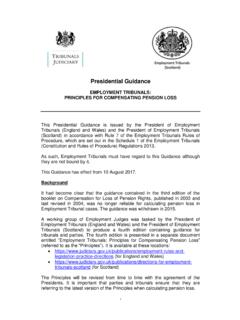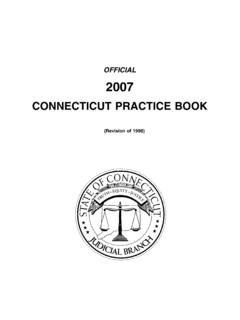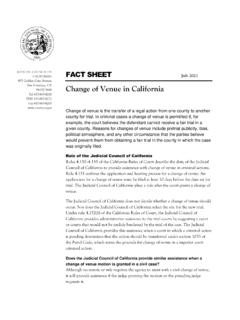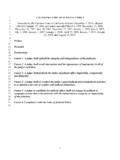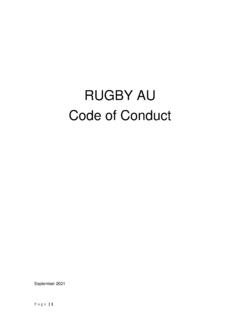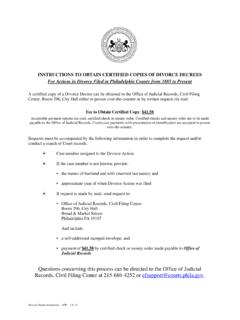Transcription of Guide to Judicial Conduct - Courts and Tribunals Judiciary
1 Guide to Judicial Conduct March 2020. Guide to Judicial Conduct Contents Contents Foreword .. 3. Part 1: Introduction .. 4. Opening remarks .. 4. To whom does the Guide apply? .. 4. How does the Guide apply?.. 4. Discipline .. 5. Part 2: Guiding principles .. 6. Judicial Independence .. 6. Impartiality .. 6. Integrity .. 7. Part 3: Guidance on specific issues .. 9. Activities outside court .. 9. Commercial activities .. 9. Community Organisations .. 9. Contact with the Legal Profession .. 11. Judicial titles .. 11. Political activities .. 12. Public Debate and the Media .. 13. References .. 15. Remuneration .. 16. Reporting personal involvement in court proceedings and criminal 16.
2 Social Activities .. 17. Personal relationships and perceived bias .. 18. Dealing with Conflicts of Interest .. 19. Behaviour towards court staff and court users .. 20. 2. Guide to Judicial Conduct Foreword Foreword The Senior President of Tribunals and I are pleased to authorise this revision of the Guide to Judicial Conduct . The Guide was first published in 2003 and was the result of extensive work by a working group of judges set up by the Judges' Council, under the chairmanship of Lord Justice Pill. The intention was not to prescribe a detailed code but to offer assistance to judges on the types of issues they might encounter and to set out principles from which they could make their own decisions and so maintain their Judicial independence.
3 Much has happened since 2003. The Constitutional Reform Act of 2005 removed many of the powers historically held by the Lord Chancellor and transferred them to the Lord Chief Justice, giving him responsibility, as Head of the Judiciary , for the welfare, training and guidance of the Judiciary of England and Wales. The Tribunals Courts and Enforcement Act 2007 created the office of Senior President of Tribunals with similar responsibility for the Tribunals Judiciary , including those in Scotland and Northern Ireland who fall within his remit. The Lord Chief Justice and the Senior President have responsibility for some 24,000 salaried and fee-paid judges, members and magistrates in Courts and Tribunals .
4 In addition, the Lord Chief Justice shares with the Lord Chancellor a disciplinary responsibility in respect of Coroners. Changes have also occurred in wider aspects of Judicial and public life. The Equality Act of 2010. has underlined the importance of equality and fairness of treatment inherent in the Judicial oath. Increased media interest in the Judiciary and the legal process has intensified public scrutiny of Judicial Conduct and decision making. And the rise of social media has presented new questions and concerns for which guidance is required. This revision is in response to these changes. It is set out in a clear and logical fashion, incorporating guidance for all Judicial officeholders, including coroners, and addressing the various issues that have arisen over the past few years.
5 What remains the same, however, is the basic set of principles guiding Judicial Conduct . Judicial independence, impartiality and integrity provide judges with a Guide , not only as to the way they discharge their Judicial functions, but also as to how they Conduct their private lives to the extent that this affects their Judicial role. They remain at the heart of this Guide and at the centre of every Judicial officeholder's Conduct . We are very grateful to Lady Justice Asplin and to the Judicial HR Committee for putting this revision together and to the officials from the Judicial Office who have supported them. We hope everyone will find it a valuable resource.
6 Lord Burnett of Maldon Sir Ernest Ryder Lord Chief Justice of England and Wales Senior President of Tribunals 3. Guide to Judicial Conduct Introduction Part 1: Introduction Opening remarks This Guide is intended to offer assistance to judges, coroners and magistrates 1 about their Conduct . It is based on the principle that responsibility for deciding whether or not a particular activity or course of Conduct is appropriate rests with each individual judge. This Guide is therefore not a code, nor does it contain rules other than where stated. Instead, it contains a set of core principles which will help judges reach their own decisions. In cases of difficulty or uncertainty, however, judges should always seek advice from the relevant leadership judge.
7 2. To whom does the Guide apply? Serving judges The Guide applies to all judges in Courts and Tribunals , whether salaried or fee-paid, legal or nonlegal. This includes magistrates and reserved Tribunals ' Judiciary operating in Scotland and Northern Ireland. It also applies to coroners. Where the officeholder's status requires a different approach, the position is made clear. Retired judges and magistrates A retired judge may still be regarded by the general public as a representative of the Judiciary . Retired judges should exercise caution and are encouraged therefore to refer to this guidance so as to avoid any activity that may tarnish the reputation of the Judiciary .
8 Retired magistrates remain subject to the Declaration and Undertaking signed on appointment. How does the Guide apply? This Guide must be read against the background of: The Terms of Appointment and Conditions of Service to which all salaried and fee-paid judges in Courts and Tribunals are subject. The Declaration and Undertaking which all magistrates sign on appointment. In addition: Some restrictions on Judicial choices are contained in statute. Section 75 of the Courts and Legal Services Act 1990 bars certain judges from legal practice. Further guidance for magistrates is contained in the Useful Information for Magistrates 1. For the ease of reference, the term judge' is used throughout and applies equally to all judges, coroners and magistrates unless otherwise stated.
9 2. The Heads of Division, the Senior Presiding Judge, Presiding Judges, Family Division Liaison Judges, Supervising Chancery Judges, Resident Judges, Designated Civil and Family Judges, Senior District Judge (Chief Magistrate); and Chamber Presidents or Regional judge, as appropriate; Chief Coroner; and Bench Chairs. 4. Guide to Judicial Conduct Introduction document available on the Judicial intranet3 and guidance on specific issues issued from time to time by the Senior Presiding Judge. The Lord Chief Justice may from time to time ask the Chief Coroner to amplify certain aspects of the Guide in relation to coroners. Rules and regulations of other professional bodies Fee paid judges are likely to be members of a professional association which may have its own set of rules and regulations.
10 Where those have legal force, in the unlikely event of a conflict with this Guide , they take precedence. Discipline The Lord Chancellor and Lord Chief Justice exercise disciplinary powers under Part 4 of the Constitutional Reform Act 2005 over all Courts and Tribunals judges, magistrates and coroners. The Judicial Conduct Investigations Office (JCIO) is established by Regulations made under the 2005 Act to assist in the handling of complaints. While the JCIO in handling complaints, and the Lord Chancellor and Lord Chief Justice in exercising their disciplinary powers, may choose to have regard to this Guide , they are not obliged to follow it.


